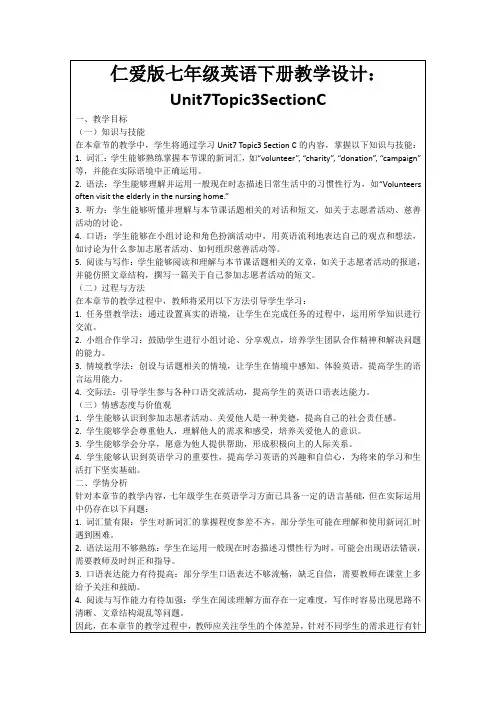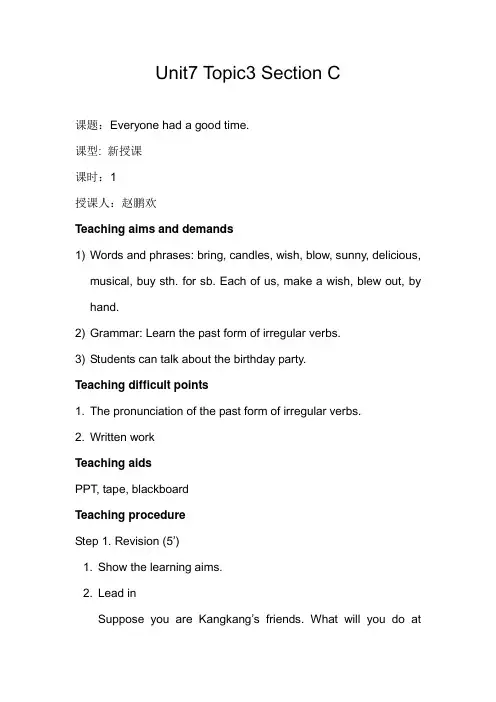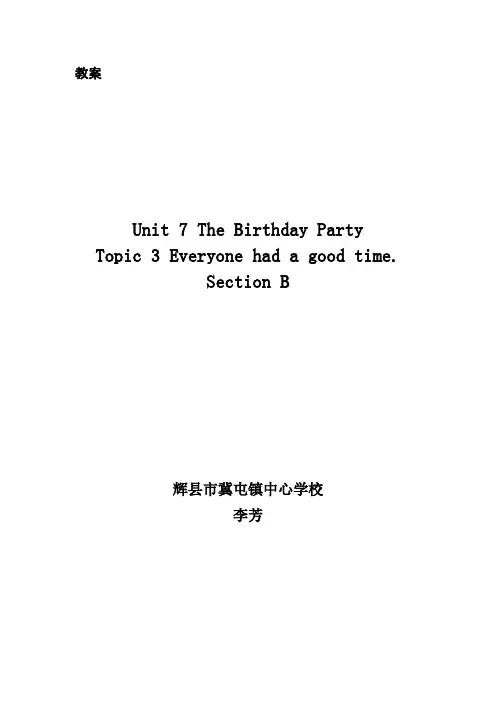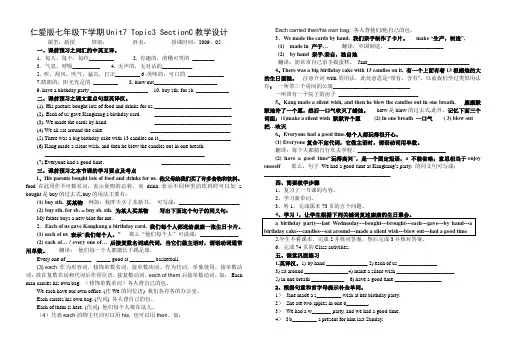仁爱版七年级英语下册教案:U7T3SC教案
仁爱版七年级英语下册教学设计:Unit7Topic3SectionC

5.预习作业:预习下一节课的内容,提前了解话题,为新课的学习做好准备。
3.阅读作业:阅读一篇与本节课话题相关的文章,如关于志愿者活动的报道或故事。要求学生总结文章大意,并标注出自己认为重要的词汇和句子。
教师提示:可以选择难易程度适中的文章,让学生在阅读过程中巩固所学知识,提高阅读理解能力。
4.词汇作业:学生自主复习本节课学习的新词汇,并尝试用这些词汇造句。要求每个词汇至少造一个句子。
教学策略:采用过程写作教学法,重视学生的写作过程,从构思、草稿到修改,逐步提升写作水平。
5.情感教育:结合教学内容,引导学生思考如何关爱他人、回馈社会,培养积极向上的价值观。
教学策略:采用情感教学法,关注学生的情感体验,引导他们从内心深处认识到所学知识的社会价值。
四、教学内容与过程
(一)导入新课
1.教师以一张志愿者活动的图片作为课堂导入,引导学生观察并提问:“What are they doing?”、“Do you know what volunteers do?”等,激发学生的好奇心和兴趣。
仁爱版七年级英语下册教学设计:Unit7Topic3SectionC
一、教学目标
(一)知识与技能
在本章节的教学中,学生将通过学习Unit7 Topic3 Section C的内容,掌握以下知识与技能:
1.词汇:学生能够熟练掌握本节课的新词汇,如“volunteer”, “charity”, “donation”, “campaign”等,并能在实际语境中正确运用。
2.学生分享自己对志愿者活动的了解,教师总结并引出本节课的主题:“Today we will learn about volunteers and charity activities.”
仁爱英语七年级下册Unit 7 Topic3 sectionC的教案

仁爱英语七年级下册Unit 7 Topic3 sectionC Everyone had a good time.的教案查巴奇民族学校姜丽Ⅰ. Aims and demands目标要求1. Learn some new words and phrases:buy lots of food , have a good time,bring many presents,make the cards, by hand, give themto friends,candles,a big birthday cake with 13 candles,sit around a cake ,make a wish,sing songsblow out, , sunny, everyone, delicious,musical,2. Learn the irregular past forms of verbs.is/am—was, are—were, do—did, sing—sang, fall—fell, go—went, forget—forgot, come—came, get —got, have/has—had, tell—told, make—made, , lose—lost, buy—bought, bring—brought, give—gave, sit—sat, blow—blew3.Talk about Kangkang's birthday party celebration.Ⅱ. Teaching aids 教具图片/挂图/pptⅢ. Five-finger Teaching Plan 五指教学方案Step 1 Review 第一步复习(时间:5分钟)复习并引入。
1. (这一课谈论的是康康的生日,教师可以问学生有没有今天或最近几天要过生日的。
如果有,大家一起唱生日快乐歌祝福他/她生日快乐。
仁爱版英语七年级下unit7topic3sectionC教学设计

Unit7 Topic3 Section C课题:Everyone had a good time.课型: 新授课课时:1授课人:赵鹏欢Teaching aims and demands1) Words and phrases: bring, candles, wish, blow, sunny, delicious,musical, buy sth. for sb. Each of us, make a wish, blew out, by hand.2) Grammar: Learn the past form of irregular verbs.3) Students can talk about the birthday party.Teaching difficult points1. The pronunciation of the past form of irregular verbs.2. Written workTeaching aidsPPT, tape, blackboardTeaching procedureStep 1. Revision (5’)1. Show the learning aims.2. Lead inSuppose you are Kangkang’s friends. What will you do atKangkang’s birthday party?Step 2. Presentation (10’)1. Pre-reading1). Look at the pictures and guess what the passage is about.2). Write a title for this passage.2. While-reading1). Listen to the tape first. While listening, please underline thepast simple in this passage.2). Ask some students to give the answer. At the same time,change the past tense into Infinitive.3). Read this passage, find out the following phrases.①为某人买某物②给某人带某物③把某物给某人④纯手工制作⑤围着……坐⑥许愿⑦吹蜡烛4). Read again. Finish 1b. Then check the answers.3. After-readingGive the key words. Try to retell this passage.Eg. ……had…for…at…. …bought…. …brought…. …gave…. …made…by hand. …liked…There was…with…. …sat around…. …made…. …blew…. We …had a good time.Step3. Practice1. Complete Kangkang’s diary.2. Read this passage.Step4. Homework1. Preview section D.2. Finish your exercise book.Teaching reflection① 过去式再次复习;文章复述比较成功;相关短语的讲解很到位。
教案(仁爱英语七年级下册7单元topic3,c)

教案Unit 7 The Birthday Party Topic 3 Everyone had a good time.Section B辉县市冀屯镇中心学校李芳Unit 7 The Birthday Party Topic 3 Everyone had a good time.Section BⅠ.Teaching aims:1. Learn the new words and expressions:matter, fall, poor, myself, wash, washroom, What’s the matter? fall down, This way, please. have a good time, come back2. Talk about the past events:I missed the chair and fell down.Did you hurt yourself?What time did you come back home last night, Judy?3. Master how to express our care in English.What’s the matter?Did you hurt yourself?Did you have a good time?Ⅱ. The key points and difficult points:1. The key points:a. Master and use the past forms of the irregular verbs.fall—fell have—had hurt—hurt get—got go —went tell—told forget—forgot buy—bought b. Use the past forms to express the past events and the birthday party celebrations.c. Master how to express our care in English.2. Difficult points:Master and use the past forms of the irregular verbs.Ⅲ. Teaching methods:Task-based language teaching and communicative language teaching.Ⅳ. Teaching procedures:Step 1 Review1. Show some verbs on the screen and choose some students to change them into their past forms.2. Revise the conversation in Section A.T: Who sang at Kangkang’s party?S1: Jane (did).T: Did she sing a Chinese song or an English song?S1: An English songT: Did she play the piano?S1: No, she didn’t. But Maria did.T: What did Tom do at Kangkang’s party?S2: He performed magic tricks.T: Did he perform magic tricks?S2: Yes, he did.T: Did he recite a poem?S2: No, he didn’t.T: What did Sally do at Kangkang’s party?S3: She danced.T: Did she perform magic tricks?S3: No, she didn’t. But Tom did.T: Did she dance?S3: Yes, she did.3. Play a game “musical chairs”with the classmates.Step 2 Presentation1. According to the game, intorduce some new words, eg: fall down, wash.2. Listen to 1a and answer the questions. Then help the students check the answers.(1) Who missed the chair?(2) Did he fall down?(3) Did he hurt himself?3. Listen to 1a again. Let the students do 1b and then check the answers.4. Point out the key words and sentences in 1a on the screen. Step 3 Consolidation1. Watch Flash 1a. Let the students pay attention to the pronunciation and intonation. Read 1a after it. Then read 1ain groups and let some groups act 1a out to the class.2. Do 1c. Let the students read 1a again. Then make up a short passage according to the key words and phrases in 1a. And choose one or two students to read theirs.3. Give the students an example and let them read it together. Step 4 Practice1. Present the picture of Judy and her father. In order to make 2a easier, introduce some key sentences and the past forms of irregular verbs.2. Let the students do 2a by themselves first without listening. Play the tape and let students check their answers, paying attention to the past forms. Play the tape again and let students follow the tape. Give students some time to read 2a in pairs.3. Read 2a again and finish 2b by themselves. Choose some students to check the answers and pay attention to the words in the blanks; Finally, let students make a summary about the past forms of the verbs they have learned.4. Listen to 3 and choose the correct answers. Then check the answers.Step 5 Summary and homework1.Make a summary about the key points.2.Homework.(1)Read and retell the dialogs in 1a and 2a in this section.(2)Remember the past forms of irregular verbs in thissection.(3)Finish Section B in the workbook.Ⅴ. Blackboard design。
仁爱七下U7 Topic3 Section C教案

Unit 7 Topic 3 Section C (1a, 1b)(Teaching Design)天城中学代春娥ⅠTeaching aims and demands:1. Knowledge Objects1). To learn some new words and phrases: make a wish, blow out, bring,candle, everyone2). To learn the irregular past forms of verbs: sing—sang, have/has—had,make—made, buy—bought, bring—brought, give—gave, sit—sat, blow—blew3). Master the following sentences:We made the cards by hand.Kangkang made a wish, and then he blew out the candles.Everyone had a good time.2. Ability goalsTo improve students’ ability of reading.3. Moral ObjectsTo train the students’ interest in learning English.ⅡTeaching key points:To be able to master some key words and phrases: bring, candle, make a wish, blow out.To enable the students to learn the irregular past forms of verbs.To talk about Kangkang’s birthday party.ⅢTeaching difficult pointsTo talk about Kangkang’s birthday party.Ⅳ Teaching proceduresStage1 Getting students ready for learningGreet and teach the new words and phrases: bring, make the cards by hand.(目的:向学生问好,吸引学生注意力,激发学生的学习兴趣)Stage 2 Pre-readingStep 1 RevisionReview the activities the children did at Kangkang’s birthday party in Section AShow the students some pictures:T: Can you remember what they did at Kangkang’s birthday party?Ss: Yes. Jane sang an English song; Sally danced; Maria played the piano;Tom performed magic tricks.Step 2 Learning some new words and phrases1.Show the students some pictures and get them to learn the new words“candle”and the phrase “sit around the cake”.2.Play the song “Happy Birthday To You”, and then ask, “Can you guess?What did Kangkang do after they sang the song.” Teach “make a wish, blow out”(目的:学习本课生词和相关句型)Stage 3 While-readingStep 1 Watching a video and answer the question: Did they have a good time?Step 2 Read the passage and circle the verbs in past forms.Step 3 1). Listen to the first Paragraph and answer: Did Kangkang like the birthday cards?2) Present Paragraph 1, answer the questions:Why did Kangkang like the birthday cards?What did Kangkang’s parents buy for his friends?Then check the answers with the students.3) Read this paragraph.Step 4 1) Listen to Paragraph 2 and check what they hear1. sat around the cake ___2. made a wish ____3. blew out the candles ____4. danced _____5. performed magic tricks _____6. sang songs ____7. played the guitar ____8. played games ____2) Present Paragraph 2 and answer:How old is Kangkang?What did the children do at the party?3) Read this paragraph.(目的:训练学生的阅读技能)Stage 5 Post-readingRetell the passage according to the pictures and phrases(目的:巩固并进一步掌握描述生日聚会的常用表达法)Stage 6 HomeworkImagine you are Kangkang. Write a passage about your birthday party. (目的:训练学生的写作能力)。
仁爱版七年级下学期Unit7 Topic3 SectionC教学设计

仁爱版七年级下学期Unit7 Topic3 SectionC教学设计课型:新授班级:姓名:授课时间:2009、05一、课前预习之词汇的中英互译。
1.每人,每个,每件_________ 2. 有趣的,滑稽可笑的________3.气息,呼吸__________ 4. 无声的,无对话的___________5. 吹,刮风,吹气,猛击,打击_________ 6 .美味的,可口的_____________7.晴朗的,阳光充足的_________ 8. blow out_______________________9.have a birthday party _____________________ 10. buy sth. for sb. ____________二、课前预习之课文重点句型英译汉。
(1). His parents bought lots of food and drinks for us.____________________________(2). Each of us gave Kangkang a birthday card. ____________________________(3). We made the cards by hand. ____________________________(4) We all sat around the cake. _____________________________(5) There was a big birthday cake with 13 candles on it.__________________________(6) Kang made a silent wish, and then he blew the candles out in one breath.__________________________________________________________(7) Everyone had a good time. _________________________三、课前预习之本节课的学习要点及考点1、His parents bought lots of food and drinks for us. 他父母给我们买了许多食物和饮料。
仁爱版七年级英语下册Unit7 Topic 3 Section C 课程教学设计
Unit 7 The Birthday partyTopic3 Everyone had a good time. Section C Analysis of the teaching material:This is the third section in Unit 7 Topic 3 in Project English. In this section, the students are going to learn the Simple Past Tense.Something about the students:The students are in Grade 7 in junior high school. Most of them are weak at English, especially at English grammar. They have learned the usage of the Simple Past Tense before. But some students are not active in the class because they are afraid of making mistakes. They don’t often use English to express themselves and communicate with others. Thus, the teacher will try to encourage them to use English in real situations and by using the language they can learn it more efficiently. Teaching aims:1. Go on learning the Simple Past Tense’.2. Train studends ability of reading.Teaching important and difficult points:1. To master the Simple Past Tense.2. Enable the studends to understand the detail of the text. Teaching method s:1.skimming,scanningTeaching aids:1. A radio and a tape.Teaching procedures:Step 1 Greating and leading in1. Let studends appreciate the Birthday Song to create an atmosphere of study.Then the teacher discusses the song with students. For example:T: Do you know the song?Ss: Yes, it’s the Birthday song.2.Encourage studends to talk about “Why do we like to celebrate our birthday?”For example:T: Why do we like to celebrate our birthday?S1: Beacurse we can receive so many gifts.S2: We can eat a delicious birthday cake.S3: We can have fun with our friends in the birthday party.S4: …3.Summarize the talks and lead to the new lesson. For example:T: Today, we’ll learn a passage about Kangkang’s birthday party . Let’s learn Section C together.设计思路: 通过有趣的话题极大的激发学生的好奇心,为进入正文打下基础。
仁爱版七年级英语下册Unit7Topic3SectionC优秀教学案例
(一)情景创设
1.教师以动物园为背景,利用图片、视频等多媒体资源,为学生营造一个生动、直观的学习环境。
2.学生通过角色扮演,置身于动物园的情境中,增强对动物特征的理解和记忆。
3.教师设计具有真实性的任务,如制作动物特征卡片,让学生在实际操作中运用所学知识。
(二)问题导向
1.教师提出一系列关于动物特征的问题,引导学生思考、讨论,从而加深对知识的理解。
3.问题导向:教师提出一系列关于动物特征的问题,引导学生思考、讨论。这种问题导向的教学策略,使学生在解决问题的过程中,加深了对知识的理解,提高their critical thinking skills。
4.反思与评价:在反思与评价环节,教师引导学生对所学知识进行反思,总结一般现在时的特殊疑问句和回答的用法。学生通过自评、互评和教师评价,了解自己的学习成果和不足之处。这种反思与评价的方式,使学生养成了自我反思的习惯,提高了他们的自我认知能力。
3.教师通过例句和练习,引导学生运用一般现在时描述动物的特征。
(三)学生小组讨论
1.教师将学生分成若干小组,每组选择一种动物,讨论该动物的外貌、特征和习性。
2.学生通过小组合作,共同完成动物特征卡片的制作,培养团队协作能力。
3.各小组展示成果,其他小组成员提问,共同检验学习效果。
(四)总结归纳
1.教师引导学生回顾本节课所学内容,总结一般现在时的特殊疑问句和回答的用法。
(四)反思与评价
1.教师引导学生对所学知识进行反思,总结一般现在时的特殊疑问句和回答的用法。
2.学生通过自评、互评和教师评价,了解自己的学习成果和不足之处。
3.教师针对学生的表现,给予及时的反馈,鼓励他们继续努力。
在教学过程中,我注重激发学生的学习兴趣,引导他们主动参与课堂活动。通过情景创设、问题导向、小组合作等策略,让学生在实际操作中掌握知识,提高他们的英语应用能力。在反思与评价环节,培养学生自我反思的习惯,提高他们的自我认知能力。同时,注重过程性评价与终结性评价相结合,全面评估学生的学习成果。
仁爱版英语七年级下unit7topic3sectionC教学设计
仁爱版英语七年级下unit7topic3sectionC教学设计第一篇:仁爱版英语七年级下unit7topic3sectionC教学设计Unit7 Topic3 Section C课题:Everyone had a good time.课型: 新授课课时:1 授课人:赵鹏欢Teaching aims and demands 1)Words and phrases: bring, candles, wish, blow, sunny, delicious, musical, buy sth.for sb.Each of us, make a wish, blew out, by hand.2)Grammar: Learn the past form of irregular verbs.3)Students can talk about the birthday party.Teaching difficult points 1.The pronunciation of the past form of irregular verbs.2.Written work Teaching aids PPT, tape, blackboard Teaching procedure Step 1.Revision(5’)1.Show the learning aims.2.Lead in Suppose you are Kangkang’s friends.What will you do at Kangkang’s birthday party? Step 2.Presentation(10’)1.Pre-reading 1).Look at the pictures and guess what the passage is about.2).Write a title for this passage.2.While-reading 1).Listen to the tape first.While listening, please underline the past simple in this passage.2).Ask some students to give the answer.At the same time,change the past tense into Infinitive.3).Read this passage, find out the following phrases.①为某人买某物②给某人带某物③把某物给某人④纯手工制作⑤围着……坐⑥许愿⑦吹蜡烛4).Read again.Finish 1b.Then check the answers.3.After-reading Give the key words.Try to retell this passage.Eg.……had…for…at….…bought….…brought….…gave….…made…by hand.…liked…There was… with….…sat around….…made….…blew….We …had a good time.Step3.Practice plete Kangkang’s diary.2.Read this passage.Step4.Homework 1.Preview section D.2.Finish your exercise book.T eaching reflection ① 过去式再次复习;文章复述比较成功;相关短语的讲解很到位。
仁爱版七年级英语下册教案:U7T3SC教学案
仁爱版七年级英语下册教案:U7T3SC教学案基于“课程标准、中招视野、两类结构” 七(下)Unit7 Topic3 Section C教案设计(新授课)汤庄一中李秋明一、学习目标确定的依据: 1、课程标准相关要求:《英语课程标准》(2021年版)要求学生能够会读会写知汉意的单词和短语单词. blow, sunny, everyone , sunny, delicious 短语: each of, by hand, make a wish, blow out. 语法:继续学习一般过去时及不规则动词的变化和用法。
2、教材分析:本节课为该话题的第3节课,建议用1课时上完。
在前2课的基础上,本节描述的是康康生日聚会活动和感受,继续学习一般过去时。
3、中招考点:一般过去时时,是学生必须掌握的知识要点,所以一定要让学生学会用用过去式表述人物的活动。
4、学情分析:通过本节对康康生日聚会活动和感受的描述,学生对一般过去时的句型结构基本了解。
二、学习目标 1.会读会写P75―76的生词、短语,会用其中的重点句子。
2..熟读1a并掌握其中的知识点。
3.学习一些不规则动词的一般过去式。
三、评价任务 1、针对目标1,通过学习P75-76的生词、短语,让学生并能熟练说出、写出P75-76的生词、短语,并能进行英汉互译。
2、针对目标2,能够正确应用短语: each of, by hand, make a wish, blow out. 3、针对目标3,能够写出buy give sit makeblow sing lose come have be 的过去式。
四、教学过程学习教学活动目标目标1:会读会写P75―76的生词、. 自学指导1 1.自学内容:课本的P75―76的生词、短语。
2.自学方法:先根据音标试读,同桌互相正音。
3.自学时间:5分钟 4.自学要求:会读,知道其汉语意思。
评价要点要点归纳通过学习P75-76的生词、短语,让学生并能熟练说出、写出1. We made the cards by hand . by hand 用手工。
- 1、下载文档前请自行甄别文档内容的完整性,平台不提供额外的编辑、内容补充、找答案等附加服务。
- 2、"仅部分预览"的文档,不可在线预览部分如存在完整性等问题,可反馈申请退款(可完整预览的文档不适用该条件!)。
- 3、如文档侵犯您的权益,请联系客服反馈,我们会尽快为您处理(人工客服工作时间:9:00-18:30)。
Section CⅠ. Material analysis:本节课是第七单元话题三的第三课时。
本节课是一节阅读、写作课,主要活动是1a,2和4a。
不仅要学习并掌握描述生日聚会的常用表达法,还会让学生通过完成康康的生日日记,学会用动词的一般过去时表达过去的事件;另外还将继续学习不规则动词的一般过去时;语音板块进一步培养学生通过音标拼读单词的能力以及掌握一般疑问句和陈述句的语调变化。
Ⅱ. Teaching aims1.Knowledge aims能够根据已学语音、音标及发音规则,正确朗读和拼写下列词汇:bring, candle, wish, blow, everyone等;能够熟练应用一般过去时叙述过去的事件、生日庆祝活动,如:We brought many presents for him.Kangkang made a wish, and then he blew out the candles.Everyone had a good time.能够正确使用不规则动词的过去式,如:lose—lost buy—bought bring—brought give—gave sit—sat blow—blew能够根据音标拼读单词以及掌握一般疑问句和陈述句的语调变化。
2. Skill aims能够识别并标出一般疑问句和陈述句的语调;能够听懂有关生日庆祝活动的对话,并作出正确的反应;能在课堂活动中交流过去的事件和生日庆祝活动的表达方式;能够读懂图片,并掌握主要信息;能够描述自己难忘的生日庆祝活动。
3. Emotional aims通过学唱英文歌曲培养学生学习英语的兴趣;乐于接触并了解异国文化。
Ⅲ. The key points and difficult points1.能够运用一般过去时叙述过去的事件、生日庆祝活动等;2.能够掌握不规则动词的一般过去时,如:lose—lost buy—bought bring—brought give—gave sit—sat blow—blew3.能根据音标拼读单词以及掌握一般疑问句和陈述句的语调变化。
Ⅳ. Learning strategies通过复述短文培养学生的语感和写作能力。
Ⅴ. Teaching aids教学挂图、录音机、黑板和多媒体Ⅵ. Teaching proceduresStep InteractionpatternsStudent activity Teacher activityIntroduction (6 minutes) 1.The wholeclass work.2.The wholeclass work.3.The wholeclass work.4.Individualwork.1.Focus theirattention on theteacher and talkabout the questionwith their partners.2.Do3. Listen tothe tape carefullyand follow the tape.3.Sing the songtogether.4.Look at the twopictures and retellthe main idea ofKangkang’sbirthday party.1.Greet students and askstudents a question: Can yousing English songs?2.Play the tape.3.Play the tape again and letstudents sing the songtogether.4.Show the pictures of 1a inSection A and Section B andlet students go over the mainideas of Kangkang’s birthdayparty. Then choose somestudents to retell it.Presentation (15 minutes) 1.Individualwork.2.Individualwork.3.Individualwork.4.Individualwork.5.The whole1.Do 1a. Read thepassage byyourselves.2.Read and try tofind the answers tothe questions.3.Point out somequestions in thepassage.e.g.His fatherbought some ... Webrought lots of ...Each of us gaveKangkang...4.Look at theblackboard and tryto recite the keywords and phrases.5.Make a title for1.Point out one question: Howdid they celebrate Kangkang’sbirthday? Do you want toknow it in detail? Let studentsread the passage bythemselves.2.Point out two questionsorally: Q1: What didKangkang’s parents buy forhis friends? Q2: Did they havea good time? Let students readthe passage again.3.Let students point out somequestions in the passage andgive answers to the questions.4.Point out the key words andphrases on the blackboard.Then let students read andrecite them:buy sth. for sb./bring sth. forsb., by hand, make a wish,have a good time.5.Let some students make aclass work.6.The whole class work. the passage.6.Write down keywords on theblackboard:had, bought, brought,gave, made, liked ...title for the passage and makea decision for the title.6.Give students 2 mins topoint out the key words in thepassage and write them downon the blackboard.Consolidation (8 minutes) 1.Individualwork.2.Individualwork.3.Individualwork.1.Do 1b. Read thepassage and try tofind the answers tothe questions;Check the answersto the questions.2.Play the gametogether.3.Do 2. Fill in theblanks and checkthe answers.1.Let students read thepassage again and answer thequestions in 1b by themselves.Choose some students tocheck the answers.2.Play the game—Changingthe verbs. Show the words inthe table in 2 and let studentstry to change the formse.g.sing—sings—singing—sang.Let students do it one by one.3.Give students 2 mins to fillin the blanks by themselvesand choose some students tocheck the answers.Practice (10 minutes) 1.Individualwork and thewhole classwork.1.Do 4a. Look andtry to read thewords and writethem together.1.Show the pictures in 4a andlet students read the wordsfirst. Then write them down.(老师可以及时纠正学生的错误)2.The whole class work. 2.Do 4b. Listen andpay attention to theintonation; Thenread and mark theintonation; Finally,check the answerstogether.2.Read some key sentences inthis lesson and let studentslisten to the teacher carefullyand pay attention to theintonation; Then let studentsread 4b by themselves andmark the last word with therising tone or the falling tone;Check the answers together.Production (6 minutes) Group work. Do it in groups andreport yourpassages to theclass.1.Give students some time tomake up a short passage usingthe key words on theblackboard in groups;(关键词已在Presentation—6 出现)Choose some students fromeach group to report theirpassages.2.Assign the homework:Find out the key phrases in 1a;Copy the verbs and their pastforms two times;Preview Section D.Teaching reflection:本节课是一节阅读课,因此,在教学过程中,培养学生的阅读理解能力是本节课的重点。
